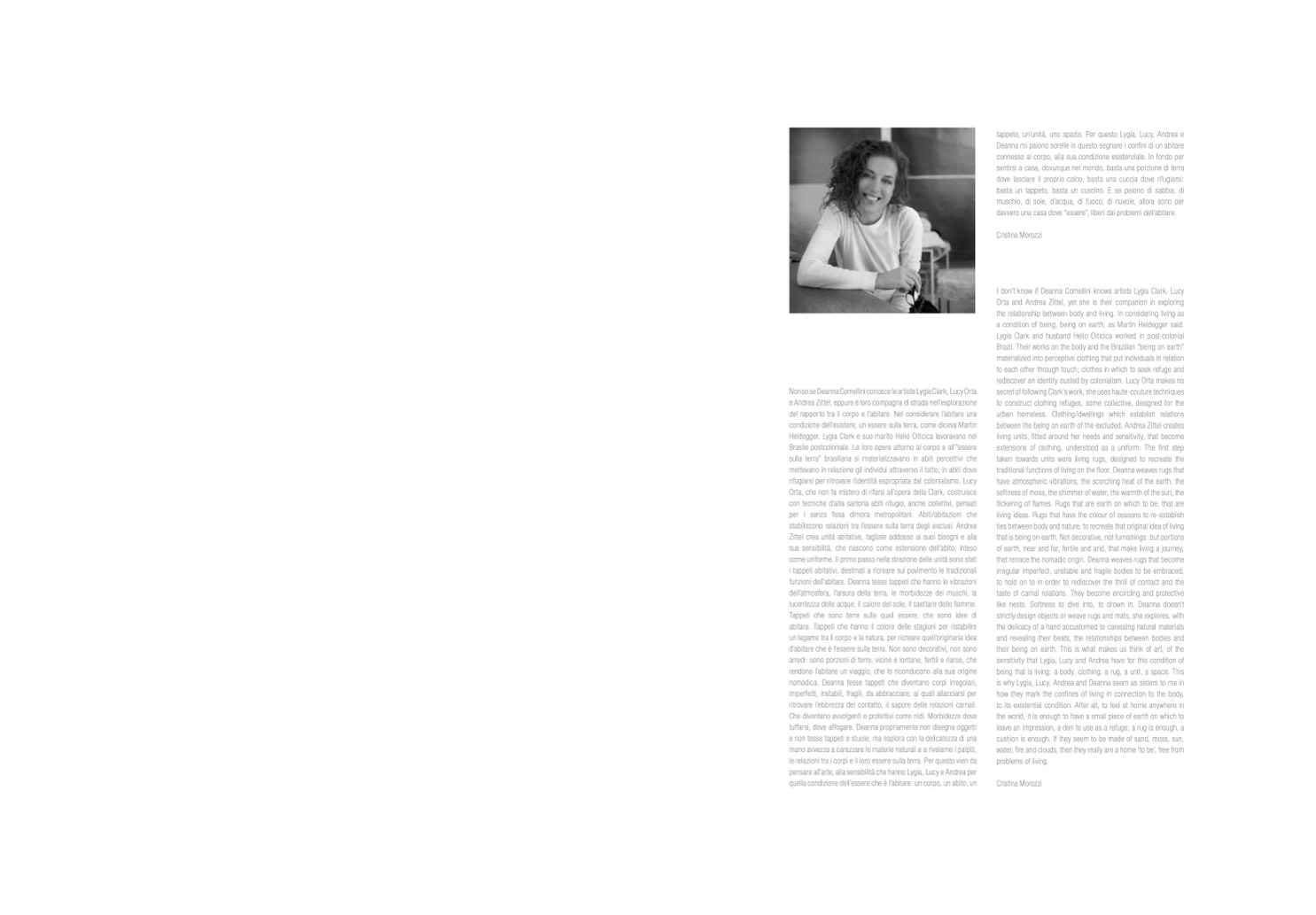
Non so se Deanna Comellini conosce le artiste Lygia Clark, Lucy Orta
e Andrea Zittel, eppure è loro compagna di strada nell’esplorazione
del rapporto tra il corpo e l’abitare. Nel considerare l’abitare una
condizione dell’esistere, un essere sulla terra, come diceva Martin
Heidegger. Lygia Clark e suo marito Helio Oiticica lavoravano nel
Brasile postcoloniale. Le loro opere attorno al corpo e all’”essere
sulla terra” brasiliana si materializzavano in abiti percettivi che
mettevano in relazione gli individui attraverso il tatto; in abiti dove
rifugiarsi per ritrovare l’identitá espropriata dal colonialismo. Lucy
Orta, che non fa mistero di rifarsi all’opera della Clark, costruisce
con tecniche d’alta sartoria abiti rifugio, anche collettivi, pensati
per i senza fissa dimora metropolitani. Abiti/abitazioni che
stabiliscono relazioni tra l’essere sulla terra degli esclusi. Andrea
Zittel crea unitá abitative, tagliate addosso ai suoi bisogni e alla
sua sensibilità, che nascono come estensione dell’abito, inteso
come uniforme. Il primo passo nella direzione delle unitá sono stati
i tappeti abitativi, destinati a ricreare sul pavimento le tradizionali
funzioni dell’abitare. Deanna tesse tappeti che hanno le vibrazioni
dell’atmosfera, l’arsura della terra, le morbidezze dei muschi, la
lucentezza delle acque, il calore del sole, il saettare delle fiamme.
Tappeti che sono terre sulle quali essere, che sono idee di
abitare. Tappeti che hanno il colore delle stagioni per ristabilire
un legame tra il corpo e la natura, per ricreare quell’originaria idea
d’abitare che è l’essere sulla terra. Non sono decorativi, non sono
arredi: sono porzioni di terre, vicine e lontane, fertili e riarse, che
rendono l’abitare un viaggio, che lo riconducono alla sua origine
nomadica. Deanna tesse tappeti che diventano corpi irregolari,
imperfetti, instabili, fragili, da abbracciare, ai quali allacciarsi per
ritrovare l’ebbrezza del contatto, il sapore delle relazioni carnali.
Che diventano avvolgenti e protettivi come nidi. Morbidezze dove
tuffarsi, dove affogare. Deanna propriamente non disegna oggetti
e non tesse tappeti e stuoie, ma esplora con la delicatezza di una
mano avvezza a carezzare le materie naturali e a rivelarne i palpiti,
le relazioni tra i corpi e il loro essere sulla terra. Per questo vien da
pensare all’arte, alla sensibilità che hanno Lygia, Lucy e Andrea per
quella condizione dell’essere che è l’abitare: un corpo, un abito, un
tappeto, un’unitá, uno spazio. Per questo Lygia, Lucy, Andrea e
Deanna mi paiono sorelle in questo segnare i confini di un abitare
connesso al corpo, alla sua condizione esistenziale. In fondo per
sentirsi a casa, dovunque nel mondo, basta una porzione di terra
dove lasciare il proprio calco, basta una cuccia dove rifugiarsi:
basta un tappeto, basta un cuscino. E se paiono di sabbia, di
muschio, di sole, d’acqua, di fuoco, di nuvole, allora sono per
davvero una casa dove “essere”, liberi dai problemi dell’abitare.
Cristina Morozzi
I don’t know if Deanna Comellini knows artists Lygia Clark, Lucy
Orta and Andrea Zittel, yet she is their companion in exploring
the relationship between body and living. In considering living as
a condition of being, being on earth, as Martin Heidegger said.
Lygia Clark and husband Helio Oiticica worked in post-colonial
Brazil. Their works on the body and the Brazilian “being on earth”
materialized into perceptive clothing that put individuals in relation
to each other through touch; clothes in which to seek refuge and
rediscover an identity ousted by colonialism. Lucy Orta makes no
secret of following Clark’s work, she uses haute-couture techniques
to construct clothing refuges, some collective, designed for the
urban homeless. Clothing/dwellings which establish relations
between the being on earth of the excluded. Andrea Zittel creates
living units, fitted around her needs and sensitivity, that become
extensions of clothing, understood as a uniform. The first step
taken towards units were living rugs, designed to recreate the
traditional functions of living on the floor. Deanna weaves rugs that
have atmospheric vibrations, the scorching heat of the earth, the
softness of moss, the shimmer of water, the warmth of the sun, the
flickering of flames. Rugs that are earth on which to be, that are
living ideas. Rugs that have the colour of seasons to re-establish
ties between body and nature, to recreate that original idea of living
that is being on earth. Not decorative, not furnishings: but portions
of earth, near and far, fertile and arid, that make living a journey,
that retrace the nomadic origin. Deanna weaves rugs that become
irregular imperfect, unstable and fragile bodies to be embraced,
to hold on to in order to rediscover the thrill of contact and the
taste of carnal relations. They become encircling and protective
like nests. Softness to dive into, to drown in. Deanna doesn’t
strictly design objects or weave rugs and mats, she explores, with
the delicacy of a hand accustomed to caressing natural materials
and revealing their beats, the relationships between bodies and
their being on earth. This is what makes us think of art, of the
sensitivity that Lygia, Lucy and Andrea have for this condition of
being that is living: a body, clothing, a rug, a unit, a space. This
is why Lygia, Lucy, Andrea and Deanna seem as sisters to me in
how they mark the confines of living in connection to the body,
to its existential condition. After all, to feel at home anywhere in
the world, it is enough to have a small piece of earth on which to
leave an impression, a den to use as a refuge; a rug is enough, a
cushion is enough. If they seem to be made of sand, moss, sun,
water, fire and clouds, then they really are a home ‘to be’, free from
problems of living.
Cristina Morozzi

